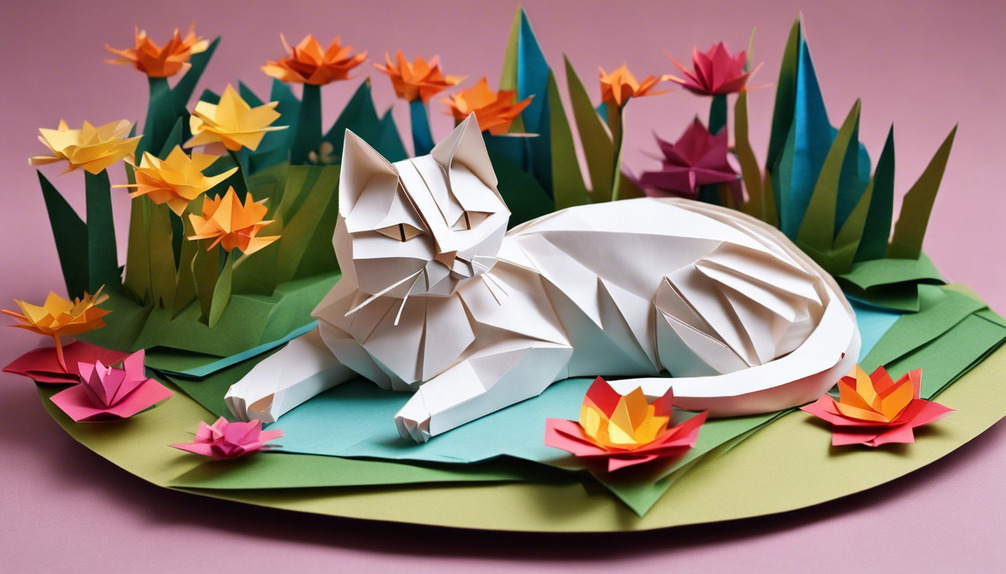When your cat’s whiskers droop and it finds jumping painful, it is apparent that your cat is experiencing joint pain. You’re not alone in this journey; many pet parents struggle with seeing their cherished companions contend with arthritis and similar ailments.
To relieve your cat’s joint pain and improve their overall wellbeing, consider implementing these ten practical tips. These suggestions are designed to make your home more comfortable and enriching for your cat, helping to alleviate their discomfort and enhance their daily life.
Stay with me as we explore the gentle adjustments you can weave into your daily routine, which could significantly soothe your cat’s suffering and potentially improve their quality of life.
Key Takeaways
- Recognize and manage arthritis symptoms, such as difficulty jumping, stiffness, and limping.
- Create a comfortable environment by providing orthopedic bedding, warmth, and easy access to resting areas and litter boxes.
- Use high-quality orthopedic beds and accessories strategically placed in serene and accessible areas.
- Incorporate joint supplements, gentle exercise, and veterinary consultation for optimal care and pain management.
Recognize Arthritis Symptoms
Spotting the signs of arthritis in your beloved cat can be key to easing their discomfort, starting with their hesitation to leap onto their favorite perch. Cats with arthritis often show subtle signs of pain that are easy to miss. You might notice your cat showing difficulty jumping, which could indicate joint pain. They may also struggle with stairs or exhibit stiffness in their legs after a restful nap.
Your cat’s daily routine offers clues, too. An arthritis-stricken cat might find it harder to use their litter box. A slight limp can emerge, becoming more pronounced over time. It’s essential to recognize arthritis symptoms early to provide the care they need.
When these signs appear, it’s time to consult your veterinarian. They can help you understand the range of treatment options available. Remember, arthritis in cats isn’t just a single issue; it’s about their overall quality of life. By staying alert to these signs and acting with compassion, you can help your cat maintain their comfort and dignity as they age.
Maintain Optimal Weight
Keeping your cat at their ideal weight is key to easing joint discomfort.
Let’s explore how you can adjust your cat’s diet and introduce regular exercise to help them stay nimble and light on their feet.
Together, we’ll find compassionate strategies to manage your cat’s weight and enhance their quality of life.
Assessing Ideal Weight
Monitoring your cat’s weight is a crucial step in ensuring their joints are cushioned by the right amount of body mass, helping to prevent discomfort. To help your arthritic cat, consider these gentle guidelines:
- Consult with Your Vet: Collaborate on a diet plan tailored for your cat’s joint health needs.
- Balanced Diet: Provide meals that support overall wellness and mitigate joint pain.
- Weight Checks: Regularly assess your cat to keep their weight within an optimal range.
- Diet Adjustments: Fine-tune their food intake as needed, based on signs of weight change.
Diet Adjustment Strategies
To maintain your cat’s optimal weight and ease joint pain, you’ll need to fine-tune their diet with the help of your vet’s personalized recommendations. If your cat has arthritis, carrying extra pounds can worsen their painful joints. A balanced diet not only helps your cat avoid unnecessary weight but also supports their overall health. The right nutrients, like omega-3 fatty acids, may alleviate chronic pain associated with OA and enhance their quality of life.
Regularly check your cat’s weight and adjust their diet accordingly. This may mean measuring their food and moderating treats. Combine these efforts with a gentle exercise regimen, ensuring food and water bowls are accessible without strain. Together, these steps will make your cat more comfortable and mobile.
Exercise for Weight Management
While adjusting your cat’s diet is essential, pairing it with regular exercise can significantly enhance their weight management and ease the stress on their joints. Here’s how you can help:
- Engage your cat in regular play sessions to encourage movement and burn calories.
- Stimulate your cat with interactive toys, like feather wands or laser pointers.
- Provide vertical spaces such as cat trees for climbing, which can make your arthritic cat more active.
- Offer toys that mimic hunting to keep playtime intriguing, like puzzle feeders.
As cat owners, you have the power to relieve your cats’ mobility issues with these steps. Always consult your veterinarian right away if you notice any changes in behavior or mobility, and remember, creating less stress for your pet is the ultimate goal.
Create Warm Resting Areas
Creating a warm and inviting resting area can significantly alleviate your cat’s joint pain, offering a cozy sanctuary for their aching body. Make sure these warm resting areas are a common feature in your home, especially in your cat’s favorite spots. Orthopedic or memory foam beds can provide the necessary joint support and, when coupled with a heated pet mat or blanket, offer that extra layer of comfort to help keep your cat feel snug and secure.
Place these beds in areas free from drafts to ensure they remain pleasantly warm. And don’t forget, accessibility is key—your cat should be able to reach these spots without too much effort, as navigating around can be a challenge when they’re in pain.
Here’s a simple guide to create these warm resting areas:
| Feature | Benefit |
|---|---|
| Orthopedic beds | Support joints and alleviate pressure |
| Heated mats/blankets | Provide consistent warmth |
| Accessibility | Easy for your cat to reach |
| Location away from drafts | Maintain a warm, comfortable environment |
Consider the placement of litter boxes around your home. It’s important to have them close to your cat’s resting places, so they don’t have to travel far. This thoughtful setup will make your cat feel loved and cared for in every aspect of their daily life.
Use Orthopedic Bedding
Orthopedic bedding, with its memory foam construction, can significantly ease your cat’s joint pain, offering them a plush and supportive spot to rest their weary bones. When considering the unique characteristics of your cat, especially if they’re an older cat or if there’s a prevalence of radiographic degenerative changes in their joints, selecting the right bed becomes a special interest in their treatment plan.
Here’s how you can create a nurturing haven for your cat:
- Choose a High-Quality Orthopedic Bed: Look for one that conforms to your cat’s body, providing relief from the pain associated with osteoarthritis.
- Ensure Warmth and Comfort: The bed should retain warmth, helping to soothe aching joints and increasing joint fluid for better mobility.
- Position the Bed Strategically: Place it in a serene, accessible area where your veterinary patient mustn’t struggle to reach it.
- Integrate into Overall Care: Remember, a proper bed is part of a holistic approach that may also include medications, like growth factor monoclonal antibodies, and other therapies.
Your cat’s comfort is paramount. An orthopedic bed will ensure their golden years are filled with as much ease and contentment as possible.
Simplify Litter Box Access
To alleviate your cat’s discomfort, ensure their litter box is easily accessible, with low sides for pain-free entry and exit. Remember, a cat begins by talking through their behavior, and difficulty in using the litter box is a sign you can’t ignore. It’s a common condition for cats with joint pain to struggle with high-sided boxes, so consider switching to an under-bed storage box.
Make sure the location of the litter box doesn’t require jumping or climbing, which can be factors that increase discomfort. Cats tend to hide their pain, but showing signs of difficulty while using the litter box indicates a need for changes. Your vet may recommend various strategies to keep your cat’s litter area comfortable and maintain control of pain associated with joint issues.
Here’s a quick reference to simplify your cat’s litter box setup:
| Feature | Benefit |
|---|---|
| Low sides | Easier entry and exit |
| Multiple locations | Less travel distance, more convenience |
| Non-slip mats | Prevent slipping, provide stability |
| Short side on enclosed boxes | Facilitate access, preserve privacy |
With these adjustments, you’ll provide your beloved cat with a litter box that caters to their needs and ensures their comfort.
Install Ramps and Steps
Ease your cat’s daily challenges by installing ramps and steps, ensuring their beloved perches remain within reach without the strain of jumping. As you consider the best ways to support your cat, remember to seek animal health information contained in reputable sources and consult with a licensed veterinarian before making decisions regarding the care of your pet.
Here are some practical steps you can take:
- Add Ramps to Elevated Areas: Create an inclined path to your cat’s favorite window sill, bed, or cat tree. Ensure these ramps have slip-resistant surfaces for secure footing.
- Improve Flooring Traction: Place non-slip rugs or carpet runners on slippery floors, or consider yoga mats that are comfortable for delicate paws.
- Upgrade Stairs: Secure non-slip stair treads on hardwood stairs to help your cat climb with ease and safety.
- Customize for Comfort: Make sure ramps and steps are the right size for your pet and positioned where they can be of most help.
Offer Joint Supplements
Incorporating joint supplements like glucosamine and chondroitin into your cat’s diet may offer much-needed relief from joint pain and improve their overall mobility. These supplements, embraced by the animal health corporate world, can be a beacon of hope for your cat, helping to restore their zest for life.
When considering these supplements, it’s essential to consult with an animal healthcare professional. They’ll guide you through the correct dosage and the best product options specifically formulated for use in cats. Companies like Zoetis Services LLC, with experts such as the Medical Lead supporting Pain, are dedicated to advancing the well-being of our beloved pets.
Be mindful that while joint supplements are beneficial, they must be used with extreme care to avoid any adverse effects, such as vomiting and injection site reactions—issues more commonly associated with pain in dogs but still pertinent to feline care. If you’re using these supplements in breeding cats, it’s even more crucial to proceed with caution.
Always monitor your cat’s reaction to the supplements and maintain open communication with your veterinarian. They’re your ally in ensuring the best care for your cat, helping to alleviate their discomfort with the utmost compassion.
Encourage Gentle Exercise
Gently guiding your cat into playful activities can help maintain their joint flexibility and offer comfort from joint pain. It’s important to ensure these exercises are kind and considerate of your cat’s condition. Here’s how you can encourage gentle exercise for your cat:
- Use interactive toys like feather wands to inspire slow-paced batting and pouncing that won’t overtax their joints.
- Point a laser toy at the floor to initiate short bursts of low-impact chasing, being mindful of their response to the activity.
- Schedule regular play sessions—lasting just a few minutes each—to keep your cat limber without causing undue stress.
- Observe your cat’s comfort levels closely, and if they show any signs of strain, give them a break and try again later.
When considering medical options, such as veterinary-approved laser therapy, the patient must be made comfortable and at ease. This innovative treatment, administered to cats at specific points, can enhance mobility and alleviate discomfort. However, cats with known allergies to certain treatments should be closely monitored.
It’s crucial to consult with animal health companies including experts to determine if your cat is a candidate for such therapies. Always make decisions under the care of a veterinary professional, ensuring the best possible outcomes for your cat’s health.
Provide Soft Grooming Tools
Selecting soft-bristled grooming tools can make all the difference in comforting a cat with joint pain during their grooming routine. When you’re gentle with the brush, you’re not only maintaining their coat but also nurturing the bond you share. It’s vital to choose tools that won’t add to their discomfort, ensuring each stroke is a soothing touch that can even help improve blood circulation.
Remember, your kind approach is as important as the tools you use.
Below is a table of recommended soft grooming tools for your beloved cat:
| Grooming Tool | Benefit | Designed For |
|---|---|---|
| Soft Bristle Brush | Gentle on Joints | Cats with Joint Pain |
| Grooming Glove | Enhances Bonding | Comfortable Experience |
| Cushioned Handle Comb | Easy to Hold | Elderly Cats |
| Long Bristle Brush | Improves Circulation | All Coat Types |
| Detangling Rake | Reduces Stress | Long-Haired Breeds |
Your compassionate care can transform a routine task into a comforting ritual that both you and your cat will cherish.
Consult Your Veterinarian
If you suspect your cat is experiencing joint pain, it’s crucial to reach out to your vet. They’re equipped to provide a professional diagnosis and can guide you through the best treatment options for your cat’s specific needs.
Seek Professional Diagnosis
When your cat shows signs of joint pain, it’s important to consult your veterinarian for a professional diagnosis to ensure they receive the best possible care. Your vet, who began her career practicing with a deep commitment to animal welfare, holds a veterinary degree that equips her to detect and control disease in domesticated cats.
Here’s what you can expect:
- A thorough clinical examination to assess your cat’s condition.
- Appropriate diagnostic tests to identify the underlying cause.
- Personalized guidance on medication, therapy, and lifestyle adjustments.
- Regular follow-ups for monitoring progress and treatment efficacy.
Your vet’s work in the animal health sector, possibly collaborating with animal health companies, is driven by educational purposes and a passion for veterinary communication. Trust in their expertise as currently the Veterinary Medical Officer who’s dedicated to your cat’s well-being.
Discuss Treatment Options
Consult with your veterinarian to explore the various treatment options that can alleviate your cat’s joint pain and improve their quality of life. Those with a veterinary degree are equipped to prescribe pain management medications and joint-specific treatments, ensuring your cat receives the compassionate care they deserve. With advancements from animal health companies, there are clinical solutions designed for cats, including Oncology and Specialty products that may offer relief.
Your vet might discuss using antibodies for the control of joint pain, and it’s crucial to consider if your cat is a pregnant or lactating queen, as this could affect treatment options. Always follow the prescribed dosage and maintain open veterinary communication to monitor your cat’s response. Stay informed about new treatments to continuously serve your cat’s needs.
Frequently Asked Questions
What Is the Best Pain Relief for Cats With Arthritis?
consult your vet for safe NSAIDs or supplements. They’ll tailor a plan with meds, comfy beds, and therapies to ease your cat’s discomfort.
How Can I Help My Senior Cat With Arthritis?
Like a gardener nurturing a delicate flower, you can help your senior cat bloom despite arthritis by ensuring they have a cozy bed, easy access to necessities, and regular vet visits for pain management.
How Do You Comfort a Cat in Pain?
You’ll comfort your aching cat by offering a quiet, cozy spot and gentle pets. Speak softly, keep their environment calm, and consult your vet for pain management strategies that will help.
When Should I Put My Cat Down With Arthritis?
When your cat continually suffers despite attempts to alleviate their pain, it’s time to consider euthanasia. Speak to a vet to make this difficult decision with empathy.




